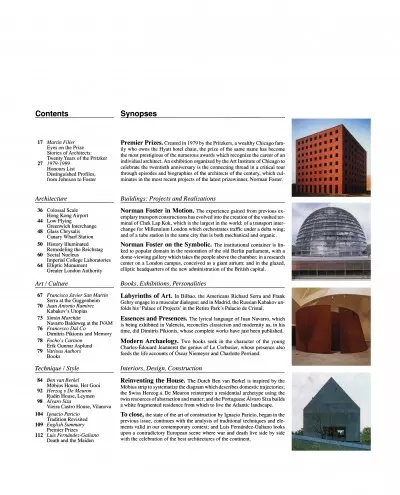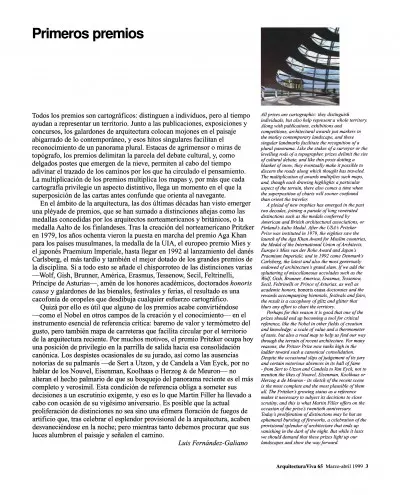Synopses
Premier Prizes. Created in 1979 by the Pritzkers, a wealthy Chicago family who owns the Hyatt hotel chain, the prize of the same name has become the most prestigious of the numerous awards which recognize the career of an individual architect. An exhibition organized by the Art Institute of Chicago to celebrate the twentieth anniversary is the connecting thread in a critical tour through episodes and biographies of the architects of the century, which culminates in the most recent projects of the latest prizewinner, Norman Foster.
Contents
Martin Filler
Eyes on the Prize
Stories of Architects:
Twenty Years of the Pritzker
1979-1999
Honours List
Distinguished Profiles,
from Johnson to Foster
Buildings: Projects and Realizations
Norman Foster in Motion. The experience gained from previous exemplary transport constructions has evolved into the creation of the vaulted terminal of Chek Lap Kok, which is the largest in the world; of a transport interchange for Millennium London which orchestrates traffic under a delta wing; and of a tube station in the same city that is both mechanical and organic. Architecture
· Colossal Scale
Hong Kong Airport
· Low Flying
Greenwich Interchange
· Glass Chrysalis
Canary Wharf StationNorman Foster on the Symbolic. The institutional container is linked to popular domain in the restoration of the old Berlin parliament, with a dome-viewing gallery which takes the people above the chamber; in a research center on a London campus, conceived as a giant atrium; and in the glazed, elliptic headquarters of the new administration of the British capital.
· History Illuminated
Remodeling the Reichstag
· Social Nucleus
Imperial College Laboratories
· Elliptic Monument
Greater London Authority
Books, Exhibitions, Personalities
Labyrinths of Art. In Bilbao, the Americans Richard Serra and Frank Gehry engage in a muscular dialogue; and in Madrid, the Russian Kabakov unfolds his ‘Palace of Projects’ in the Retiro Park’s Palacio de Cristal. Art / Culture
Francisco Javier San Martín
Serra at the Guggenheim
Juan Antonio Ramírez
Kabakov’s UtopiasEssences and Presences. The lyrical language of Juan Navarro, which is being exhibited in Valencia, reconciles classicism and modernity as, in his time, did Dimitris Pikionis, whose complete works have just been published. Simón Marchán
Navarro Baldeweg at the IVAM
Francesco Dal Co
Pikionis and MemoryModern Archaelogy. Two books seek in the character of the young Charles-Édouard Jeanneret the genius of Le Corbusier, whose presence also feeds the life accounts of Óscar Niemeyer and Charlotte Perriand. Historietas de Focho
Erik Gunnar Asplund
Various Authors
Books
Interiors, Design, Construction
Reinventing the House. The Dutch Ben van Berkel is inspired by the Möbius strip to systematize the diagram which describes domestic trajectories; the Swiss Herzog & De Meuron reinterpret a residential archetype using the twin resources of abstraction and matter; and the Portuguese Álvaro Siza builds a white fragmented residence from which to live the Atlantic landscape. Technique / Style
Ben van Berkel
Möbius House, Het Gooi
Herzog y De Meuron
Rudin House, Leymen
Álvaro Siza
Vieira Castro House, VilanovaTo close, the state of the art of construction by Ignacio Paricio, began in the previous issue, continues with the analysis of traditional techniques and elements valid in our contemporary context; and Luis Fernández-Galiano looks upon a contradictory European scene where war and death live side by side with the celebration of the best architectures of the continent. Ignacio Paricio
Tradition Revisited
Resumen en inglés
Premier Prizes
Luis Fernández-Galiano
Death and the Maiden
Luis Fernández-Galiano
Premier Prizes
All prizes are cartographic: they distinguish individuals, but also help represent a whole territory. Along with publications, exhibitions and competitions, architectural awards put markers in the motley contemporary landscape, and these singular landmarks facilitate the recognition of a plural panorama. Like the stakes of a surveyor or the levelling rods of a topographer, prizes delimit the site of cultural debate, and like thin posts dotting a blanket of snow, they eventually make it possible to discern the roads along which thought has traveled. The multiplication of awards multiplies such maps, and, though each drawing highlights a particular aspect of the terrain, there also comes a time when the superposition of charts will sooner confound than orient the traveler.
A pleiad of new trophies has emerged in the past two decades, joining a parade of long venerated distinctions such as the medals conferred by American and British architectural associations, or Finland’s Aalto Medal. After the USA’s Pritzker Prize was instituted in 1979, the eighties saw the launch of the Aga Khan Award for Muslim countries, the Medal of the International Union of Architects, Europe’s Mies van der Rohe Award and Japan’s Praemium Imperiale, and in 1992 came Denmark’s Carlsberg, the latest and also the most generously endowed of architecture’s grand slam. If we add the spluttering of miscellaneous accolades such as the Wolf, Gish, Brunner, America, Erasmus, Tessenow, Secil, Feltrinelli or Prince of Asturias, as well as academic honors, honoris causa doctorates and the rewards accompanying biennials, festivals and fairs, the result is a cacophony of glitz and glitter that blurs any effort to chart the territory.
Perhaps for this reason it is good that one of the prizes should end up becoming a tool for critical reference, like the Nobel in other fields of creation and knowledge: a scale of value and a thermometer of taste, but also a road map to help us find our way through the terrain of recent architecture. For many reasons, the Pritzer Prize now ranks high in the ladder toward such a canonical consolidation. Despite the occasional slips of judgement of its jury and certain notorious absences in its hall of fame – from Sert to Utzon and Candela to Van Eyck, not to mention the likes of Nouvel, Eisenman, Koolhaas or Herzog & de Meuron - its sketch of the recent scene is the most complete and the most plausible of them all. The Pritzker’s growing status as a reference makes it necessary to subject its decisions to close scrutiny, and this is what Martin Filler offers on the occasion of the prize’s twentieth anniversary. Today’s proliferation of distinctions may be but an ephemeral bursting of fireworks, a celebration of the provisional splendor of architecture that ends up vanishing in the dark of the night. But while it lasts we should demand that these prizes light up our landscapes and show the way forward.








